 |
|
|
|
 |
|
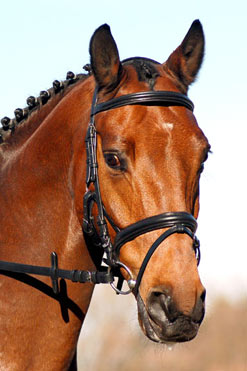
|
|
Takes pressure off the poll |
|
|
Relaxes topline
|
|
Content horses |
|
 |
|
|
|
Tested and recommended by well-known trainers and therapists |
| |
 |
|
The ST-Bridle is allowed in Germany, The Netherlands, Austria and Switzerland as well as in International competition .
|
|
 |
|
 |
|
|
|
| How it works |
 |
|
How a regular bridle works |
|
 |
|
With a regular bridle there is a thin strip of leather from the noseband that runs over the poll. Most times the noseband is fastened so that it lies firmly on the horse. Because the horses head is wedge-shaped, when the horse chews or moves his jaw, the noseband inevitably slides down. The pressure on the poll therefore increases. Between P1 and P2 is a curved line. P3 is the highest point. When the horse opens his mouth the curve between P1 and P2 is straightened. Through this action there is a pulling force on P3 towards the horse’s mouth that creates a right-angles bearing on P4, increasing the pressure on the horse’s poll P4.
|
.jpg) |
|
 |
|
How the ST-bridle works |
|
|
| |
The Poll is one of the horse’s most sensitive parts. Nerves, vertebrae, bursas, as well as meridians are all very close together in this small space. Strong pressure in this area can quickly change the behavior of the horse. |
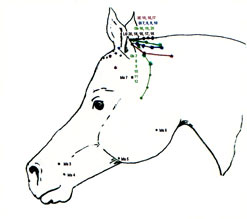 |
The ST-Bridle has been engineered to minimize the pressure
on the horse’s poll!
|
| The ST-Bridle System |
|
Due to the unique fastening system - through the lower jaw strap and the flash noseband – the bridle can be precisely fastened on the horse's head. Because the connection between the noseband and the headpiece is triangular the pressure on the horse's poll is released and the cheekbone is left free. The contact area and therefore the pressure on the poll are equally distributed thanks to the identically fastened buckles on both sides. Now, the bridle cannot shift out of place. Therefore, the rider's actions will no longer cause any irritations on the poll and the bit always sits straight in the horse's mouth. For double bridles, the two bits can never get caught again. Between P1/P2 and P3 the same reaction as described. The pressure point goes in a W-angle. This comes through the cheek piece B1. The lower jaw strap U and the cheek piece B1 construct a parallelogram to divide the pressure. The stronger the pressure B1 on W is, optimal result is the pressure going in the direction of the horses neck > reduced pressure on B2 > minimal pressure on point P4.
|
|
|
|
 |
|
Description |
|
 |
|

|
The headpiece ...
... is only one piece, without the strap that usually holds the noseband
... is wedge-shaped and softly padded. |
|
 |
|
|
... has a big contact area.
... had gaps for the ears. |
|
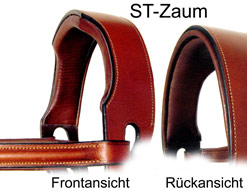 |
| |
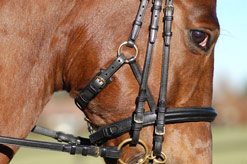
|
The ST-bridle angle
... takes pressure off the poll through the
mechanical dispersion of pressure.
<<< back |
| |
|
Models and prices: |
 |
|
|
|
 |
|
The ST-Bridle is available in following models:
|
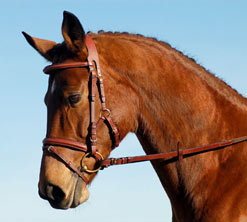

|
|
ST-Bridle Size warmblood with cut out headpiece
Color: brown, Black
Color of metal fittings:brass, silver
Price: 181,40 € excluding tax |
| |
ST-Bridle Size thoroughbred , also for
large ponies
Color: black
Color of metal fittings:brass, silver
Price: 181,40 € excluding tax
|
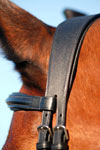 |
| |
ST-Double Bridle
Color: brown, black
Color of metal fittings: silver, brass (only for black)
Price 267,25 € excluding tax |
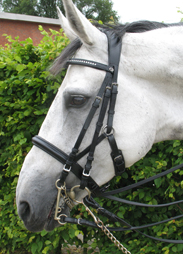
|
| |
<<< back |
To secure the ST-bridle: |
To secure the ST-Snaffle and ST-Double bridle correctly please note the following:
-
Fix all buckles evenly on each side
-
When fitted the noseband of the ST-Bridle, whilst loose, should lie approximatley 1cm under the cheekbone.
-
Now the underjaw strap can be tightened so the noseband is secured at the cheekbone and the cheekpiece shows a clear angle.
-
Once the noseband is closed it will automatically slip into position under the cheekbone.
-
The rest of the bridle can then be secured like a normal bridle.
|
 |
|
|
 |
| |
 |
|
|
|
|
